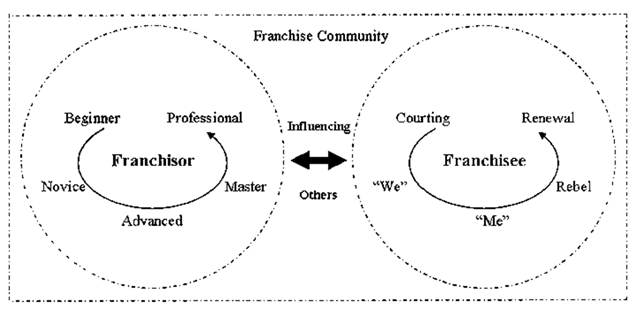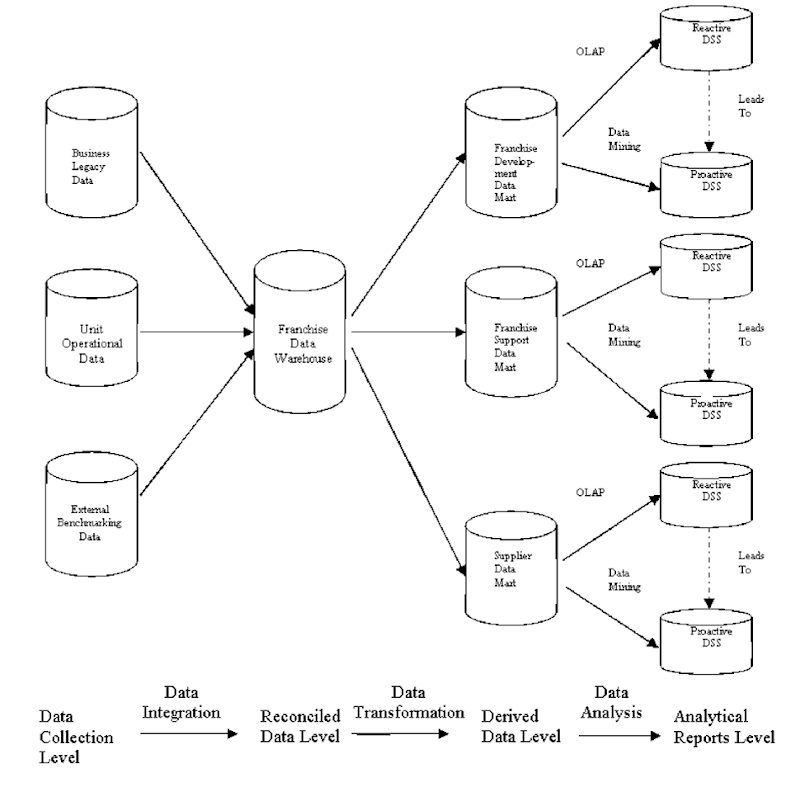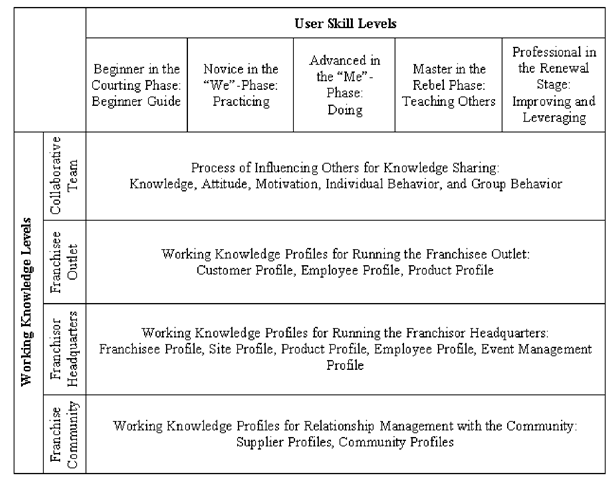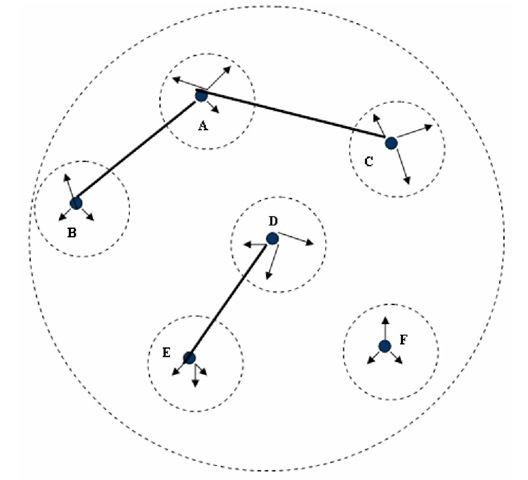INTRODUCTION
Franchising has been a popular business approach given the high rate of business failures (Justis & Judd, 2002; Thomas & Seid, 2000), and its popularity continues to increase in today’s e-business-centered global economy. For example, Entrepreneur magazine%well known for its Franchise 500 listing%in early 2001 included a category called Tech Businesses into its Franchise Zone which contains subcategories of Internet Businesses, Tech Training, and Miscellaneous Tech Businesses. At the time of this writing, 35 companies are on the list of Entrepreneur.com. Netchising, combing the power of the Internet for global demand-and-supply processes and international franchising arrangements for local responsiveness, seems to rise as an effective global e-business growth strategy (Beck & Morrison, 2000; Morrison, Beck & Bouquet, 2000). The Netchising business model “offers potentially huge benefits over traditional exporting or foreign direct investment approaches to globalization” and is “a powerful concept with potentially broad applications” (Davenport, 2000, p. 52).
In his best seller, Business @ the Speed of Thought, Bill Gates (1999) wrote: “Information technology and business are becoming inextricably interwoven. I don’t think anybody can talk meaningfully about one without talking about the other” (p. 6). Gates’ point is quite true indeed when one talks about data mining in franchise organizations. Despite its popularity as a global e-business growth strategy, there is no guarantee that the franchising business model will render continuous success in the hypercompetitive environment. This can be evidenced from the constant up-and-down ranking of the Franchise 500 by Entrepreneur.com. Thus, to see how data mining can be “meaningfully” used in franchise organizations, one needs to know how franchising really works. In the next section, we show that (1) building up a good “family” relationship between the franchisor and the franchisee is the real essence of franchising, and (2) proven working knowledge is the foundation of the “family” relationship. We then discuss in the following three sections the process of how to make data mining “meaningful” in franchising. Finally, future trends of data mining in Netchising are briefly described
FRANCHISING: THE FRANCHISOR/ FRANCHISEE RELATIONSHIP
Franchising is “a business opportunity by which the owner (producer or distributor) of a service or a trade-marked product grants exclusive rights to an individual for the local distribution and/or sale of the service or product, and in return receives a payment or royalty and conformance to quality standards. The individual or business granting the business rights is called the franchisor, and the individual or business granted the right to operate in accordance with the chosen method to produce or sell the product or service is called the franchisee” (Justis & Judd, 2002, pp. 1-3). Developing a good “family” relationship between the franchisor and the franchisee is believed to be the most important factor for the success of a franchise (Justis & Judd, 2002). Figure 1 describes how such a “family” relationship is built in the franchise community.
In Figure 1, the franchisor has to learn to deal with many issues to increase the business. The learning process is incrementally developed through the following five stages (Justis & Judd, 2002): (1) Beginner%learning how to do it; (2) Novice%practicing doing it; (3) Advanced%doing it; (4) Master%teaching others to do it; and (5) Professional%becoming the best that you can be. At a higher stage of the development, most of the problems in the previous stages have been dealt with. However, more complicated and challenging questions will arise as the franchise continues the expansion. This is especially true when the system reaches the stage of
Figure 1. Understanding how the franchisor/franchisee “family” relationship works

Professional, when many unforeseen and difficult problems could happen all of sudden. Bud Hadfield (1995), the founder of Kwik Kopy franchise and the International Center of Entrepreneurial Development, aptly stated: “The more the company grows, the more it will be tested” (p. 156). To capture the learning process, a counter-clockwise round arrow surrounding the franchisor is used to depict the increasing intensity of learning as the franchisor continues surviving and thriving.
To understand how the “family” relationship is developed, one needs to know the five phases of franchisee life cycle (Schreuder, Krige & Parker, 2000): (1) Courting: both the franchisee and the franchisor are excited with the relationship; (2) “We”: the relationship starts to deteriorate, but the franchisee still values the relationship; (3) “Me”: the franchisee starts to question the reasons for payments-related issues with the attitude that the success so far is purely of his/her own work; (4) Rebel: the franchisee starts to challenge the restrictions being placed; and (5) Renewal: the franchisee realizes the “win-win” solution is to continue teaming up with the franchisor to grow the system. Similar to the franchisor, a counterclockwise round arrow surrounding the franchisee is used in Figure 1 to depict the increasing intensity of franchisee life cycle as the franchisee continues learning and growing in the franchise system.
While the franchisee progresses through the life cycle, the “family” relationship is gradually developed through a process of influencing others (Justis & Vincent, 2001), as depicted in Figure 1 with a bi-directional arrow: (1) working knowledge, proven abilities of expanding the franchise system profitably; (2) positive attitude, constructive ways of presenting and sharing the working knowledge; (3) good motivation, providing incentives for learning or teaching the working knowledge; (4) positive individual behavior, understanding and leveraging the strengths of the participants to learn and enhance the working knowledge; and (5) collaborative group behavior, having the team spirit to find the best way to collect, dissimilate, and manage the hard-earned working knowledge. By going through the processes of learning and influencing, both the franchisor and franchisee gain the working knowledge in the franchise community progressively. The franchisor, the franchisee, and the franchise community in Figure 1 are surrounded with dashed lines, meaning there is no limit to the learning process.
MANAGING FRANCHISE ORGANIZATIONAL DATA
There are many contact points within the franchise community where the franchisor and the franchisee can influence each other; in business these contact points are sometimes called “touchpoints.” Based on the Customer Service Life Cycle (CSLC) model developed by Ives (2004), Chen, Chong, and Justis (2002) proposed a framework (see Table 1) to harness the Internet to serve the customers for the franchising industry. The 11 sub-stages in Table 1 are based on two well-known franchising topics by Justis and Judd (2002) and Thomas and Seid (2000).
The model in Table 1 may be used as a comprehensive guide for a franchise system to develop its Web site, especially at the stages of Requirements and Acquisition.
Table 1 also is a comprehensive framework for a franchise organization to model the data needed to serve its customers, that is, franchisees and their customers. A well-designed Internet strategy shall empower the franchisor and the franchisees to collect, use, renew, store, retrieve, transmit, and share the organizational data needed to do the collaborative work in different phases of the CSLC model. Specifically, three types of data are needed:
• Operational data: the daily activities at (1) the franchisor headquarters, including six major entity types: employees; business outlets owned by franchisees or companies; prospective franchisees; product development; suppliers (e.g., marketing agents, accountants, insurance providers, attorneys, real estate agents); and government offices, (e.g., taxes and worker compensation); and (2) the franchisee business outlet, including six major entity types: customers, employees, contacts with the headquarters, product inventory, suppliers, and government offices.
• External data: the relationship management activities in the franchise community, including three major entity types: the relationship with customers, the relationship with partners and suppliers, and the performance benchmarks in the industry.
• Legacy data: the activities that have been working well or gradually adapted since the franchise system came into existence. Examples include (1) rewarding activities to the top performers among the franchisees; (2) efficient procedural activities for the employees at the headquarters supporting the franchisees; and (3) effective and friendly face-to-face activities for the field representatives to serve the franchisees at their outlets.
MANAGING FRANCHISE ORGANIZATIONAL INFORMATION
An architecture, adapted from Inmon (1996), of data mining in franchise organizations with respect to the franchisor/franchisee relationship management depicted in Figure 1 is shown in Figure 2. The architecture consists of four levels: (1) data collection, holding operational, external, and legacy data collected from the franchise business environment; (2) reconciled data, holding data warehouse data that are subject-oriented, integrated, time-variant, and non-volatile (Inmon, 1996); (3) derived data, containing several data marts (e.g., franchisees, customers, competitors, and suppliers) derived from the data warehouse based on various franchisee/customer-centered segmentations; and (4) the analytical reporting level, producing various relationship performance reports (e.g., business outlet periodical summary, financial, scorecards, and mysterious shopping) for the decision makers using the decision support systems (DSS) for their decision making. To move from the data collection level to the reconciled data level, data integration is needed. It is a very time-consuming process that involves the activities such as cleansing, extracting, filtering, conditioning,scrubbing, and loading. To move from the reconciled data level to the derived data level, data transformation is needed which involves the activities such as replication, propagation, summary, aggregate, and metadata. To move from the derived data level to the analytical reporting level, data analysis is needed which involves two major activities%online analytical processing (OLAP) and data mining.
Table 1. The customer-service-life-cycle model in franchising
| CSLC | Sub-stages | Example: Technology Strategies of WSI Internet Civww.wsrcorporate.com) |
| Requirements | Understanding How Franchising Works | Internet |
| Investigating Franchise Opportunities | Internet • Global Gateway • Internet Solutions • Portfolio & Technologies • About Us • Franchise Opportunities • Experts Online • Interactive Online |
|
| Obtaining Franchisee Prospectus | Internet • E-mail | |
| Making the Choice | Internet | |
| Acquisition | Preparing Business Plan | Internet |
| Financing the Franchisee! Business | Internet | |
| Signing the Contract | Internet | |
| Owners hip | Marketing & Promoting the Franchise ProductsiServices | Internet/Intranet /Extranet • Need a Website? • Live Call • Employment @ WSI • Hot News • WSI ICE Flash • Message from the President |
| Managing the Franchise System | Internet Intranet • Serving Franchise es’ Customers Extranet |
|
| Building the Relationship between the Franchisor and the Franchisee | Internet Intranet | |
| • The Courting Phase • The “We”-Phase • The “Me”-Phase • The Rebel Phase • The Renewal Phase |
• Knowledge Centre • Training at Headquarters • Newsletter • Meetings • Toll-free Phone Line Extranet • Purchasing Cooperatives |
|
| Renewal or Retirement | Becoming a Professional Multi-unit Franchisee or Retiring from the | Internet Intranet |
| Franchise System | Extranet |
A typical OLAP analysis consists of pre-defined multidimensional queries. Some examples in franchising are shown below:
• Show the gross margin by product category and by franchise outlets from Thanksgiving to Christmas in the last five years.
Figure 2. An architecture of data mining in franchise organizations

• Which franchise outlets are increasing in sales and which are decreasing?
• Which kinds of customers place the same orders on a regular basis at certain franchise outlets?
• How many franchisees did we lose during the last quarter of2001, compared to 2000, 1999, and 1998?
Other OLAP activities include spreadsheet analysis, data visualization, and a variety of statistical data modeling methods. Since the query activities are pre-defined, we call the supporting systems reactive DSS.
Data mining, on the other hand, is used to identify hidden relationship patterns of the data residing in the data marts. Typical data mining modeling analysis can be classified into the following three categories:
• Classification and Prediction, using techniques such as RFM (recency, frequency, and monetary), regression, decision tree, and neural network
• Association Rules, using techniques such as market basket analysis, correlation analysis, cross-sell analysis, and link analysis
• Cluster Analysis, using techniques such as partition, hierarchy, outlier, and density analysis
Table 2, adapted from Delmater and Hancock (2001), shows that data mining techniques can be used to help serve franchisees’ customers at the different stages of the CSLC model.
Since the data mining queries and related activities are not pre-defined, we call the supporting systems proactive DSS. A major drawback of proactive data mining is that without careful preliminary examination of the data characteristics, the mining activities may end in vain (Delmater & Hancock, 2001). In order to achieve a higher success rate of data mining, we suggest (on the right side of Figure 2) that OLAP-based queries need to be conducted first. For example, one may find, through daily OLAP queries, that certain segments of customers buy certain products frequently. This pattern may lead us to do more in-depth proactive analysis of the customers and products relationships. The result may help the company serve customers better and generate higher profits.
Table 2. Franchisees’ customers data mining using the CSLC approach
| CSLC | Explanation | Data Mining Activities (and Techniques Used) |
| Requirements | Finding and reaching the customers | • Lead Generation • Market Analysis & Segmentation (Classification and Prediction) • Mining Web Site Visitors (Association Rules) • Text Mining Usenet Newsgroups (Cluster Analysis) |
| Acquisition | Selling to the customers | • Custo m er Ac qui s lti o n Pro fil ing • CustornerSe gm e ntatio nStrategy(Classific atio n and Prediction) • Online Shopping Tracking (Association Rules) • Pricing Strategy (Association Rules) • Customer-centric Selling (Association Rules) • Text Mining Contact E-Mails (Cluster Analysis) • Scenano Notification (AssociationRules) |
| Ownership | Satisfying the customers after the sales | • Customer Service • Inquiry Routing (AssociationRules) • Text Mining E-Mails & Inquiries (Cluster Analysis) • Sc enano Notifi cation (AssociationRules) • Staffing Le v e 1 Pre di cti o n (C la s s lfi c atio n and Prediction) |
| Retirement or Renewing | Retaining the customers so that you can continue coming back | • Customer Retention • Sharp erCustomerFocus thro ugh Lo yalty Pro gr am (C las s lfi c atio n and Pre die tio n) • Detecting Customer Complaints through Text Mining (Cluster Analysis) • Detecting Inappropriate Customer Services (Cluster Analysis) • Individual CustomerProfiles (Classificationand Prediction) • Sc enano Notifi cation (AssociationRules) |
MANAGING FRANCHISE ORGANIZATIONAL KNOWLEDGE
As was mentioned in the discussions of Figure 1, the key for building the franchisor/franchisee “family” relationship is in the franchise organizational learning. In addition, there are five vital factors for a successful learning program: knowledge, attitude, motivation, individual behavior, and group behavior. Thus, working knowledge is the real foundation of a successful franchise “family” relationship. The working knowledge is structured in many forms of profiles that are embedded in the operational manuals of the franchise business processes. Table 3 gives some examples of those working knowledge profiles with respect to the CSLC business processes associated with the sub-stages in Table 1.
A working knowledge profile is developed when a certain task of the CSLC process is repeated many times with good results. Consider the Site Profile used at the “Marketing & Promoting the Franchise Products/Services” sub-stage in Table 3. The Site Profile is used to help the new franchisee to find a good business site, and typically it is the real estate department at the franchisor headquarters which is responsible in developing the profile. The Site Profile is continuously being tested and enhanced. Various OLAP/Data Mining analytical reports monitoring the performance of the sites are generated at the Analytical Reports Level shown in Figure 2. Based on those reports, the real estate experts and their teams are able to fine-tune the attributes and the parameters within the Site Profile. Most often, the corresponding data collection procedures in the CSLC sub-stage also need to be revised and perfected so that better report scorecards can be generated.
This process of enhancing the working knowledge profile will achieve its high peak when both the franchisor and the franchisees are arriving at the Professional and Renewal stage of growth. A significant phenomenon of being a Professional franchisor and a Renewal franchisee are their ability to leverage the assets of the hard-earned working knowledge profiles into dynamic capabilities and high-business-value-creation completive-advantage strategies. The new products or services coming out of the process of leveraging the working knowledge profiles may transform the franchise business into a more, sometimes surprisingly, profitable enterprise. The capability of leveraging the assets of franchise working knowledge into profitable products or services is at the heart of a successful franchise.
Consider as an example the site selection working knowledge at McDonald’s. The Franchise Realty Corporation real estate business, a result of site selection asset leveraging, is the real money-making engine at McDonald’s. This can be evidenced from the following speech of Ray Kroc, founder of McDonald’s, to the MBA class at the University of Texas at Austin in 1974: “Ladies and gentlemen, I’m not in the hamburger business. My business is real estate” (Kiyosaki, 2000, p. 85), In the topic McDonald’s: Behind the Arches (Love, 1995, p. 152), Kroc commented further: “What converted McDonald’s into a money machine had nothing to do with Ray Kroc or the McDonald brothers or even the popularity of McDonald’s hamburgers, French fries, and milk shakes. Rather, McDonald’s made its money on real estate….” McDonald’s makes money out of real estate by leasing properties from landlords and then subleasing the stores to the franchisees. The Professional franchisees, many of them are multi-unit operators, can then focus on expending the business without worrying about finding good locations for the growth. This money-making real estate strategy is what separates McDonald’s from other fast-food chains (David, 2003).
Knowledge repository systems, consisting of working knowledge profiles such as the one shown in Figure 3, can be linked into the franchisor headquarters and the franchisee outlets for knowledge sharing and learning. Such a repository has two dimensions. First, there is a working knowledge level for the collaborative team, the franchisee outlet, the franchisor headquarters, and the franchise community. Second, there are user skill levels, including Beginner in the Courting Phase, Novice in the “We”-Phase, Advanced in the “Me”-Phase, Master in the Rebel Phase (since the rebel ones tend to be those who know the system very well and are capable of influencing others to follow them), and Professional in the Renewal Stage of the franchisee life cycle. The foundation of the framework is the working knowledge of the five crucial elements—Knowledge, Attitude, Motivation, Individual Behavior, and Group Behavior—used by the collaborative team, to effectively influence others in building the franchise “family” relationship. The working knowledge profiles at the franchisee outlet, the franchisor headquarters, and the franchise community can be modularized according to the user’s level. An intranet-based curriculum of working knowledge modules can then be designed for the users to learn the working knowledge profiles effectively.
FUTURE TRENDS
The third industrial revolution, combining Internet technology with globalization, produces various new data mining opportunities for the growth of franchise organizations. For example, knowledge network applications, using data mining techniques such as social network analysis (Wasserman & Faust, 1994), can be developed to connect Professional franchisees in the world. The goal is to enable the franchise system to venture into new global emerging markets% for example, China% through international franchising, and develop innovative products/services through asset leveraging. This could be done because franchise capabilities, structured in the working knowledge repository shown in Figure 3, enable the Professional franchisees to work with the franchisor to continuously improve and leverage the current franchise working knowledge. An example of knowledge networks of Professional franchisees can be illustrated in Figure 4. There are six Professional franchisees (A-F) in the figure, with three clusters (A-C, D-E, and F) of knowledge networks. Each Professional franchisee (a dot) has his/her personal knowledge network (arrows pointing out of the dot) tested and built over the years while doing day-to-day problem solving at the franchisee outlet. The knowledge network may include the customers’ likes and dislikes, the kind of employees to hire, the competitors’ and suppliers’ pricing strategies, and the social needs in the local community. Each Professional franchisee is surrounded with a circle with dashed lines, meaning there is no limit to the personal knowledge network. In order to solve the problems more effectively, Professional franchisees may share with each other their approaches. Thus, clusters (connected dots) of knowledge network are formed for solving various problems more effectively.
Table 3. The CSLC model of franchise working knowledge
| CSLC Sub-stages | Examples of Working Knowledge Profiles |
| Understanding How Franchising | • Lead Generation Profile |
| Works | • Website Visitor Profile |
| Investigating Franchise | • Benchmark Profile |
| Opportunities | • Successful Franchisee Profile |
| Obtaining Franchisee Prospectus | • Prospectus Profile |
| Making the Choice | • Competitor Profile |
| Preparing Business Plan | • Business Plan Profile |
| Financing the Franchised | • Financing Institute Profile |
| Business | • Non-traditional Franchising Profile |
| Signing the Contract | • Franchisee Profile |
| Marketing & Promoting the | • Site Profile |
| Franchise Products/Services | • Customer Profile • Product Profile |
| Managing the Franchise System | • Support Team Profile • Employee Profile • Supplier Profile |
| Building the Relationship | • Event Management Profile |
| between the Franchisor and the | • Best Practices Profile |
| Franchisee | • Crisis Management Profile |
| Becoming a Professional | • Multi-unit Franchisee Profile |
| Franchisee or Retiring from the | • Co-branding Profile |
| Franchise System | • Opportunities Profile • Social Network Profile |
CONCLUSION
Franchising has been popular as a growth strategy for small businesses; it is even more so in today’s global and e-commerce world. The essence of franchising lies in managing the “family” relationship between the franchisor and the franchisee. In this article we showed data mining plays an important role in growing and nurturing such a “family” relationship. Specifically, we discussed: (1) how franchise organizational data can be managed effectively using the methodology of Customer Service Life Cycle; (2) how franchise organizational information is deciphered from the customer-centered data using OLAP and data mining analytical techniques; and (3) how the franchise organizational knowledge is leveraged to grow the franchise system. The ability to continue leveraging the organizational knowledge assets based on the good “family” relationship is really what a franchise business is about.
Figure 3. Working knowledge repository in franchise organizations
Figure 4. Knowledge networks of professional franchisees
KEY TERMS
Customer Service Life Cycle: Serving customers based on a process of four stages: Requirements, Acquisition, Ownership, and Retirement. Many companies are using the approach to harness the Internet to serve the customers.
Data Mart: A small database with data derived from a data warehouse.
Data Mining: Analytical techniques used to find out the hidden relationships or patterns residing in the organizational data.
Data Warehouse: A database that is subject-oriented, integrated, time-variant, and non-volatile.
Franchisee: The individual or business who receives the business rights and pays the royalties for using the rights.
Franchisee Life Cycle: The stages a franchisee goes through in the franchise system: Courting, ‘We,’ ‘Me,’ Rebel, Renewal.
Franchising: A business opportunity based on granting the business rights and collecting royalties in return.
Franchisor: The individual or business who grants the business rights.
Franchisor/Franchisee Learning Process: The stages of learning, including Beginner, Novice, Advanced, Master, and Professional.
Franchisor/Franchisee Relationship Management:The vital factor for the success of a franchise, including: Knowledge, Attitude, Motivation, Individual Behavior, and Group Behavior.


